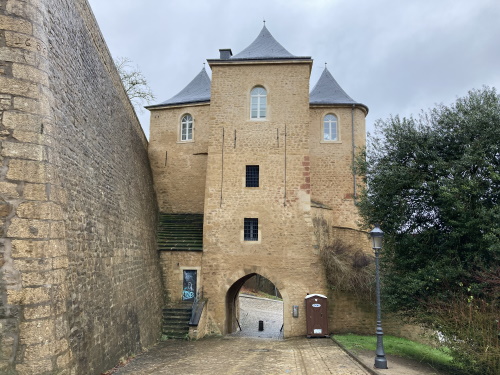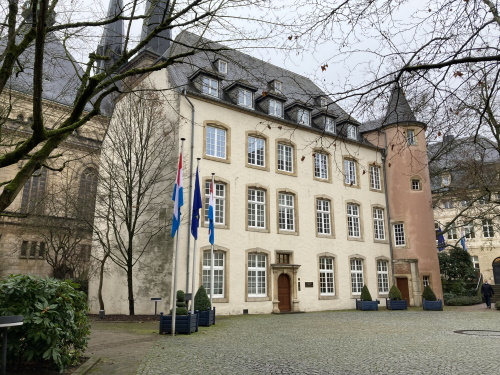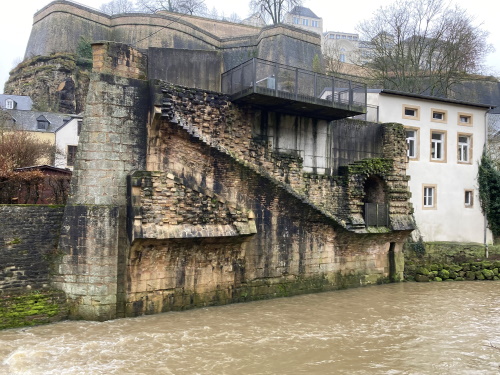Blog WHS Visits
Luxembourg revisited
Generally, I find it hard to prepare for sites within my own region with the same level of detail as I do for more exotic WHS. For example the City of Luxembourg: I had been there in 1984 and 2001, but couldn’t tell you more than I liked the panoramas. Most of the other reviews to date are also fairly superficial. A breakthrough in the knowledge of this WHS came when Jurre recently suggested some 25 new connections for it. During a 3 night revisit right after Christmas 2021, I further discovered that from a WH perspective it has at least 3 remarkable features that I was not aware of beforehand: its boundaries, a list of 20 notable monuments, and controversy before inscription.
The Boundaries
Although Luxemburg’s city centre is only small already, the core zone of this WHS covers an even smaller part. There is a hugely detailed official map available, but on the ground, the borders between core and buffer zones are hard to distinguish. Unfortunately, not everything that looks like an old rampart is included, neither is every 19th-century public building. Previous reviewers mentioned Fort Thüngen, Place Guillaume, and Place d'Armes, but these are all outside of the core zone, as are most of the bridges and parts of the Wenzel Circular Walk.
I found the WH plaque at a viewpoint in the Chemin de la Corniche, directly below St. Michael’s Church. The WH certificate is in a drawer in the City Museum. The museum includes a "UNESCO visitor center" too, but in the brochures on offer, the boundaries of the WHS core zone are also not strictly followed.
The 20 Monuments
The best guidance for a thorough visit is the map mentioned above: it shows 20 numbered places of interest. These 20 are detailed in the AB evaluation too, in a descriptive manner that is uncommon nowadays. On foot, I tracked down all 20 within an hour or 2 - an enjoyable, self-invented scavenger hunt. The most interesting ones were the two-story Castle bridge (#2), the fine residence Maison de Bourgogne (#14), and the Tree Towers (#7).
Along the way, helped by the information panels that are omnipresent in the city center, I even found us some more connections: there are 17th-century man-made terraces below the Bock-rock, the Tutesall used to be horse stables, the Ecluse du Grund was a sluice consisting of "a massive masonry dam" that could be opened to inundate the surrounding area as a method of defense (irrigation and drainage), and Renaissance sculptures are prominent in the Notre Dame cathedral.
The Controversy
This is the first evaluation document that I know of with evidence of a dispute within the evaluating party (ICOMOS). “A distinguished French expert in the field of military structures”, Dr. Nicolas Faucherre, opposed inscription as in his opinion, not enough was left after the dismantling of Luxembourg’s fortifications in the late 19th century as a result of the Treaty of London. The expert mission, however, resulted in positive advice, because of its historical significance and “remarkable harmony between the city and its landscape”. I found it strange to see that no further comparative analysis was executed, and I doubt that the City of Luxembourg would get inscribed nowadays as the historic city center is unremarkable and the fortifications are mostly gone.
Els - 9 January 2022
Comments
Meltwaterfalls 9 January 2022
I have a real soft spot for Luxembourg. I’m not 100% sure quite why, culturally it is very quiet, and it didn’t exactly have a throbbing nightlife, but I have been three times and have throughly enjoyed each one.
I was surprised at how limited the WHS boundaries are though. It covers most of the parts I would have imagined, though I am a little surprised the Petrusse ravine and bridges aren’t included.
Thanks for doing a bit of digging though, hopefully it will come in useful for my next visit!
Astraftis 9 January 2022
I visited Luxemburg on a whim, just to complete the BeNeLux capitals, and it was a big surprise. It's such an intricated and complex cityscape! And it has a couple of great museums presnting the country uder all aspects. Moreover it was winter and I wandered alone the fortifications immersed in the fog, a surreal experience. I wonder how (apparently) it's not a more popular destination! An extension would make sense indeed.


